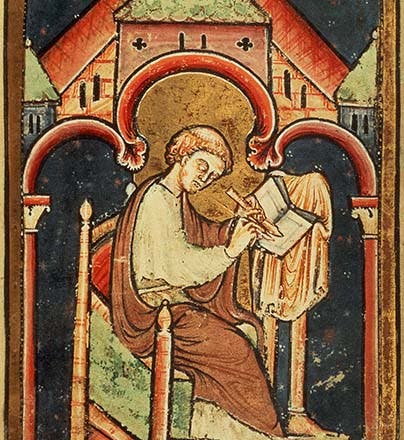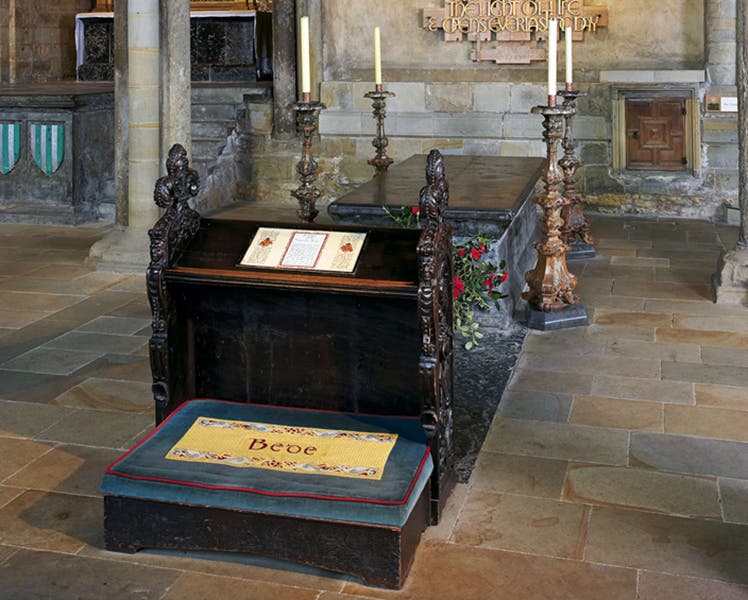Scientist of the Day - Venerable Bede
Venerable Bede, an English monk, died May 26, 735. Bede is sometimes called Saint Bede, or just Bede, but in my opinion, when "Venerable" is an option for a first name, you don't pass it up. Bede lived in a monastery in northeast England, in what was then called Northumbia, and is now Tyne and Wear, along the river Tyne, and his remains, what is left of them after several forced moves, are in the cathedral at Durham, not too far from his home monastery in Jarrow. For all his monkish ways, Bede played a fairly major role in the establishment of modern chronology, with his book, De ratione temporum (On the Reckoning of Time, 725 A.D.).
Chronology, the science of time, can be a rather overwhelming discipline in the modern world, and was so even in early modern times, but in the 8th-century Christian world, chronology was very straightforward and had only one goal: to calculate the date of Easter. It even had its own name: computus. Unlike most other holy days, which are pinned to a specific day of the calendar, Easter floats; it was traditionally the first Sunday after the first full moon after the spring equinox. Even if you were a good astronomer and knew when the full moon and the spring equinox would be in a particular year, that didn't solve the problem, for the full moon in the sky was not necessarily the full moon in the lunar calendar, and the actual first day of spring could differ by a few days from the equinox in the Church calendar. So in the 6th and 7th centuries, different Christian regions (such as Ireland and Anglo-Saxon England) celebrated Easter on different days, which was unacceptable to everyone – Easter was the holiest day of the year, and needed to be fixed precisely and universally for each year.
Several of Bede's predecessors in computus took a major step forward by realizing that one could construct an Easter calendar based on the Metonic cycle, a Greek discovery from the time of Plato that 19 solar years almost exactly equal 235 synodic months (a synodic month is the time it takes the moon to go through one set of phases, about 29 1/2 days). If a full moon occurs on a certain day of the year, then 19 years later, it will occur once again on that same day. So one can construct a 19-year Easter calendar, and just such a thing was done by Dionysius Exiguus (Dennis the Short!) in 525 A.D. In fact, he constructed a series of four of them in a row, covering the period from 532 to 626 A.D. And he also introduced another innovation: he tied all of his Easter dates to a starting point. It was customary in his day to indicate the year by relating it to the reign of the Roman emperor ("15th year of Diocletian”), or by naming the two consuls who ruled that year, or by indicating the years since the founding of Rome. Dionysius tied his Easter calendar to the Incarnation of Christ, thus introducing what we call the anno Domini, or A.D. system.
But Dionysius used A.D. dates only for his Easter tables, and no one else used them at all. One of Bede's contributions was to revive the A.D. system in his De ratione temporum, while at the same time constructing an Easter table that extended over 540 years, from 523 to 1063 A.D., thus providing an Easter date for the next 300 years. It was Bede's table that settled the Easter question from that time forth. Even Ireland gave up their Easter calculations in favor of Bede's, and the rest of Europe followed suit.
There are at least 50 manuscripts of De ratione temporum that survive; we show the first page of a 12th-century copy in the University of Glasgow Library (second image, above), and another that is in the British Library (third image, above). We also reproduce a 19-year Metonic lunar table from the Glasgow manuscript (fourth image, below)
Bede not only adopted the A.D. chronology for his computus, but he used it historically, the very first to do so. In 731, he published An Ecclesiastical History of the English People, in which he referred all dates to the birth of Christ. Since this was the most popular and influential historical work from the early medieval period, A.D. dates soon spread and took root (B.C. dates would have to wait until the 15th century).
Bede made one final contribution to the reckoning of time. A few 6th- and 7th-century computists had attempted to find the days since the creation of the world, and had reckoned that 5200 years or so had passed between the Creation and the Incarnation, which meant, if you lived in 650 AD, that the world was almost 6000 years old. Since many believed that the world would last only 6000 years, this meant that the Second Coming was almost upon us, and the end of the world was at hand. Bede used his astronomical, Biblical, and historical knowledge to recalculate the date, and came up with 3952 B.C. for the date of Creation. This was the first of the "4000 BC" Creation dates, which would set a precedent that would last into the 18th century. Its most important effect was to remove the millennial feeling that had gripped Christians who thought the world had just about run its course. Bede pushed the Second Coming into the future and gave the present back to believers, and that may have been his most important legacy.
There is no true portrait of Bede, but there are several representations in various Bede manuscripts. We show one in a British Library manuscript of Bede’s Life of St. Cuthbert (first image). There are other stylized portraits that appears as illuminations in various Bede manuscripts (see second image). The only real memorial we have for Bede is his tomb in Durham cathedral. The top is a plain stone slab on which has been carved: HIC SUNT IN FOSSA BEDAE VENERABILIS OSSA. Although this is not the original slab, the inscription was copied from an earlier one, and translates as: “Here in this tomb lie the bones of the Venerable Bede”. This is the source, apparently the only source, for referring to St. Bede as the Venerable Bede.
Durham cathedral, one of the finest surviving examples of Norman architecture, is, along with nearby Durham castle, a World Heritage Site, and the very first line of the description states: “Durham Cathedral was built in the late 11th and early 12th centuries to house the relics of St Cuthbert (evangelizer of Northumbria) and the Venerable Bede.” Durham cathederal has its own World Heritage website, where you can learn more about Bede, Cuthbert, and the cathedral, but not much more, I am afraid, about Bede’s contribution to computus and chronology
Dr. William B. Ashworth, Jr., Consultant for the History of Science, Linda Hall Library and Associate Professor emeritus, Department of History, University of Missouri-Kansas City. Comments or corrections are welcome; please direct to ashworthw@umkc.edu.








![Columbine, hand-colored woodcut, [Gart der Gesundheit], printed by Peter Schoeffer, Mainz, chap. 162, 1485 (Linda Hall Library)](https://assets-us-01.kc-usercontent.com:443/9dd25524-761a-000d-d79f-86a5086d4774/3829b99e-a030-4a36-8bdd-27295454c30c/gart1.jpg?w=210&h=210&auto=format&fit=crop)

